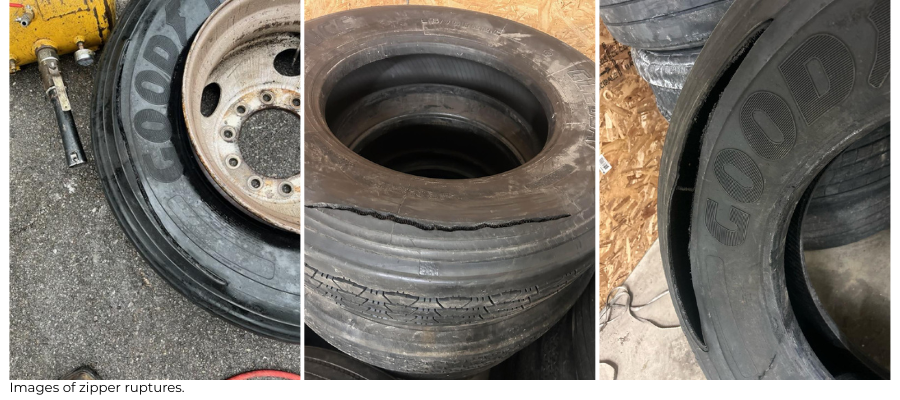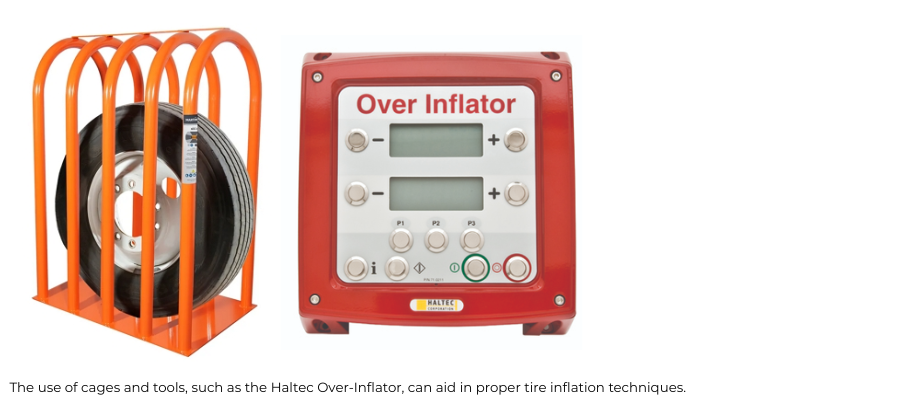Creating an account with Rubber-Inc. is quick and easy. Join Now
Safety Bulletin: Zipper Ruptures
Zipper Ruptures in Steel Cord Radial Truck Tires
PURPOSE
The purpose of this bulletin is to explain what a zipper rupture is, what causes it, and why it is extremely dangerous. We will also review how to prevent zipper ruptures, including proper inspection techniques and inflation procedures.
What is a Zipper Rupture?A zipper rupture is a dangerous sidewall tear that can occur in steel cord radial medium and light truck tires. It appears as a long tear along the tire's circumference.

- Explosive Force: Zipper ruptures can occur at any inflation pressure, but they are more likely to happen above 20 psi. The escaping air creates a powerful explosion that can cause serious injury or death.
- Safety Cages: While safety cages can contain the tire and rim assembly, they cannot contain the forceful blast of air.
Preventing Zipper Ruptures:
- Proper Inflation: Maintain the correct tire pressure as specified by the manufacturer.
- Regular Inspection: Regularly inspect tires for signs of damage, such as bulges, cracks, or exposed cords.
- Safe Inflation Practices: Use an OSHA-approved safety cage when inflating tires. Maintain a safe distance from the tire during inflation.
Inspecting Tires for Potential Zipper Ruptures:
- Deflate and Remove: Deflate the tire completely and remove it from the vehicle. Demount tire from rim/wheel
- Visual Inspection: Look for punctures, bulges, cuts, or exposed cords.
- Hands-on Inspection: Feel for soft spots, distortions, or protruding wire filaments.
- Non-destructive Testing: If available, use methods like shearography or X-ray to check for internal damage.
Inflation Procedures:
-
Initial Inflation: Mount the tire on the rim and inflate "with the core removed" to 5 psi to seal the beads. Place the assembly in a safety cage.
- Safety Gear: Always wear appropriate safety gear.
-
Safe Distance: Maintain a safe distance from the tire during inflation. Always remain outside of the tire’s trajectory.
- Monitor for Distress: Stop the inflation process immediately if you hear unusual noises or see signs of distress.
- Inflation to 20 psi: With the Core removed, Inflate the tire to 20 psi.
- Over-Inflation Technique:
- For light truck and medium truck tires, inflate to 20 psi over the cold inflation pressure (but do not exceed 120 psi).
-
For bus and refuse tires, inflate to 20 psi over the cold inflation pressure (follow manufacturer's recommendations).
-
If none of these conditions are present, adjust the inflation pressure to the recommended operating inflation pressure and install the valve core.

Important Safety Considerations:
- OSHA Compliance: Follow all OSHA regulations and manufacturer guidelines.
Tire Disposition:
- Repairable Damage: If the tire has minor damage, refer it to a tire professional for repair.
- Non-repairable Damage: If the tire exhibits signs of a potential zipper rupture, mark it as unserviceable and scrap it.
Remember:
- Prioritize safety when handling tires.
- Follow recommended inspection and maintenance procedures.
- Be aware of the dangers of zipper ruptures.
Additional Resources:
For additional information on tire safety and zipper ruptures we recommend visiting the Tire Industry Association (TIA), USTMA, and the Technology and Maintenance Council of the American Trucking Associations (TMC).
Copyright © 2025, All rights reserved by Rubber-Inc.
